Culture of Romania
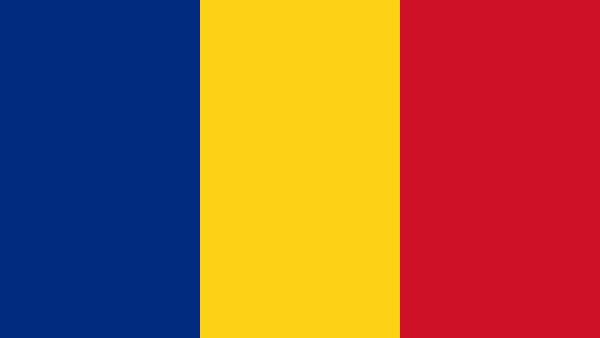
Culture Name
Romanian
Orientation
Identification. The name "Romania," which was first used when the three regions of the country were united in 1859, reflects the influence of ancient Rome on the nation's language and culture. The three regions—Walachia, Moldavia, and Transylvania—are relatively culturally uniform. An exception is the Hungarian community in Transylvania, which has its own language and traditions and considers itself Hungarian. The Roma (Gypsies), who are scattered throughout the country, mostly in small camps on the outskirts of towns and cities, are in many ways culturally unassimilated.
Location and Geography. Romania is in southeastern Europe at the north end of the Balkan peninsula, bordering Ukraine and Moldova to the north, Hungary to the northwest, Serbia to the southwest, Bulgaria to the south, and the Black Sea to the east. The land area is 91,699 square miles (237,500 square kilometers). The Carpathian Mountains cover about one-third of the country; they surround the Transylvanian Plateau and divide it from the other two main regions: Moldavia in the northeast and Walachia in the south. The Transylvanian Alps in the central region contain the highest peak, Mount Moldoveanu. The eastern and southern regions are characterized by rolling plains.
The Danube River stretches through the country for six hundred miles, forming its southern border with Serbia and Bulgaria and emptying into the Black Sea in the east. It is a source for irrigation and hydroelectric power.
Serious environmental problems include soil erosion and water and air pollution from unregulated industrial development. Because of economic hardship, the government has been slow to enforce laws that place restraints on industry.
Demography. The population was estimated to be 22,411,121 in 2000. Ninety percent of the people are Romanian, 7 percent are Hungarian, and 2 percent are Roma. The remainder is made up of Germans, Ukrainians, and others. Estimates of the Roma population range from 400,000 to one million; it is difficult to pinpoint because of the Roma's nomadic lifestyle. Before World War II, there was a large Jewish population, but almost 400,000 Jews were killed during the Nazi years, and many of the remaining Jews emigrated to Israel after the war. Today the Jewish population is estimated at less than 10,000. The German population has also decreased significantly. In the 1980s, Ceaucescu's government charged citizens large sums for permission to leave the country, a policy Germans felt was aimed specifically at them. Since Ceaucescu's regime fell in 1989, many Germans have emigrated.
Linguistic Affiliation. The official language is Romanian, which has Latin roots that date back to the Roman occupation of the area but also contains words from Greek, Slavic languages, and Turkish. In the fourteenth century, the country adopted the Cyrillic alphabet, but it later reverted to Roman lettering. Magyar (the language of ethnic Hungarians) and German are spoken, as are Serbian, Ukrainian, Slovak, Czech, Bulgarian, and Turkish. The language of the Roma population is Romany, although many Roma combine that language with Romanian.
Symbolism. The flag consists of blue, yellow, and red vertical stripes that symbolize Transylvania, Moldavia, and Walachia, respectively. The coat of arms, adopted in 1992, consists of a gold eagle against a blue background holding a cross in its beak, a sword in one claw, and a scepter in the other. Emblazoned on the eagle's chest are the symbols of the five provinces: Walachia, Moldavia, Transylvania, Banat, and Dobruja.
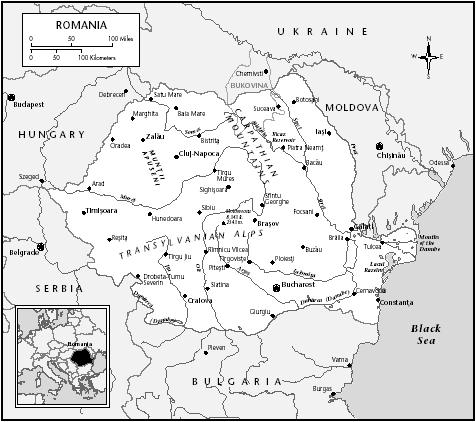
Romania
History and Ethnic Relations
Emergence of the Nation. The first known inhabitants of present-day Romania were called Dacians. They were conquered by the Roman Empire in 106 C.E. Roman domination of the region lasted only until 271 but had a formative and long-lasting influence. Many Romans stayed and intermarried with the Dacians, helping to shape the customs and language of the region.
From the 200s through the 1100s, there was a series of invasions by various tribes from the north, including the Magyars and the Saxons. The northern region developed into a principality called Transylvania, the south into a principality called Walachia, and the east into Moldavia. Throughout the fourteenth and fifteenth centuries, Walachia and Moldavia battled repeated invasions by the Ottoman Empire. They eventually succumbed around 1500 and spent more than three hundred years under Turkish rule. In 1601, the principalities of Moldavia, Walachia, and Transylvania were united for the first time under Prince Michael the Brave. During Michael's reign, Romania maintained a degree of sovereignty, but after his death, the Turks again dominated the region. They ruled through Greek officials who abused their power to exploit the peasants.
In the late 1700s and early 1800s, the Ottoman Empire was weakened by a series of defeats to the Russians. In 1821, an uprising in Walachia against the Greek rulers ended in the execution of the Romanian leader Tudor Vladimirescu, which further fanned desires for independence. The 1829 Treaty of Adrianpolie replaced Greek rule with Russian. In 1834, the Russians withdrew. In 1859, Prince Alexander Cuza was elected ruler of a united Moldavia and Walachia; three years later, the country was renamed Romania (then spelled Rumania). Cuza attempted to redistribute land and improve the living conditions of the poor, but those policies were unpopular with the upper class; in 1866, Cuza was forced to resign and was replaced by Prince Carol. In 1877, Carol led a successful joint revolt of Romanian and Russian troops against the Turks. The Congress of Berlin of 1879 marked the end of Turkish domination. Romania became a kingdom in 1881, and Prince Carol was crowned king.
Despite the nation's independence, the situation of the majority of the people remained unchanged. In 1907, increasing discontentment gave rise to a peasant revolt, in which the country estates of the nobility were burned. The army suppressed the uprising, killing ten thousand people.
In 1914, King Carol died and Ferdinand I took his place. Two years later, Romania entered World War I, joining the Allies in their fight against the Axis powers (Austria-Hungary and Germany in particular). After the war, the Trianon Treaty doubled the size of the country, uniting Moldavia and Walachia with Transylvania, Banat, Bessarabia (present-day Moldova), and Bucovina (today in southern Ukraine). In the years after World War I, a fascist movement called the Iron Guard won a large following in response to threats from the communist Soviet Union and rising unemployment.
Ferdinand died in 1927 and was succeeded by his son, Carol II, in 1930. Carol II resorted to military suppression of the opposition. In 1938 he outlawed political parties, and the head of the Iron Guard was executed.
At the outbreak of World War II, Carol II was forced to give up significant portions of the country to Russia and Hungary. His son Michael took the throne in 1940, but the real power fell to Marshal Ion Antonescu. In an effort to recoup Soviet-occupied territories, the country aligned itself with the German forces, participating in the invasion of the Soviet Union in 1941.
In August 1944, King Michael took power back from Antonescu. Romania joined the Allied forces but was soon occupied by Russia. After the war ended in 1945, most of the occupied territories were returned, but the Russian communists retained control. They abolished the monarchy in 1947, replacing King Michael with a puppet government under the leadership of Petru Groza. Business and industry were nationalized, and farmland was taken from the peasants and reorganized into government-run collectives. The communist leadership also imposed harsh penalties for expressing opposition to the government, imprisoning dissidents or putting them to work in extremely dangerous labor projects. Gheorghe Gheorghiu-Dej served as chief of state throughout the 1950s and was responsible for many of the Stalinist policies. In the early 1960s, he worked to distance Romania more from Soviet influence.
In 1965, Nicolae Ceausescu assumed the presidency and presented a new constitution. He initiated large-scale development projects, mainly with money borrowed from other countries. Many of those projects failed, sinking the country into debt that Ceaucescu attempted to pay off by exporting virtually everything the country produced, leading to severe shortages of food and fuel. The secret police kept the people in line through terror while Ceaucescu and his family, who controlled most of the government, continued to plunder the country for personal gain.
In the 1980s, worsening food shortages, along with the toppling of other communist regimes in Eastern Europe, stirred unrest. Protests in 1987 were put down with a combination of military force and extra food distribution. In December 1989, protests in the city of Timisoara were met with gunfire, and hundreds of citizens died. Other protests broke out across the country, and the situation escalated until troops refused to follow orders and joined the protesters. Ceaucescu and his wife attempted to flee the country but were halted by the army and brought to trial. Both were found guilty of murder and put to death by firing squad on Christmas Day 1989.
A party called the National Salvation Front assumed power, and in 1990 free elections were held. Ion Iliescu, the leader of the National Salvation Front and a former Communist Party member, won the presidency, and a new constitution was adopted in 1991. Iliescu put down student protests against the government by calling in twenty thousand coal miners to create a counter demonstration and later used the same tactic to force Petre Roman, a liberal prime minister, from office. Despite widespread dissatisfaction with Iliescu's leadership, he won reelection in October 1992. Four years later, voters replaced him with the reform-touting Emil Constantinescu of the Democratic Convention of Romania. Despite positive changes during his term, the December 2000 elections were a contest between Iliescu and Corneliu Vadim Tudor of the right-wing Greater Romania Party, who espoused a hard-line fascist ideology. Iliescu won the vote of a disillusioned, bitter, and frightened populace.
National Identity. The majority of residents share a common culture and history dating back to the Dacians. National identity is informed by pride in the country's resilience and ability to withstand attacks from the Austro-Hungarian Empire and the Turks and later from the Soviet Union. Many Hungarians living in Transylvania consider themselves more Hungarian than Romanian, and some consider the region a part of Hungary.
Ethnic Relations. Transylvania was once under Hungarian control, and parts of the region still have an ethnic Hungarian majority. Relations between Hungarians and Romanians are tense and have resulted in political conflict and occasional violence. In 1976, the communist government outlawed the use of the Hungarian language in education and the media in what it claimed was an effort to assimilate minorities into the national culture. Since 1989, the government has softened its stance, but discrimination still exists.
Romania has one of the world's largest populations of Roma. The Roma have a long history of persecution throughout Europe and still face discrimination. They have high rates of poverty, unemployment, and malnutrition, and many have left in an attempt to better their conditions.
During World War II, Jews were persecuted by both the government and the German military, and many were deported to Nazi concentration camps. Most of those remaining emigrated to Israel after World War II. Today, most of the country's Jews are concentrated in northern Moldavia and Bucharest.
Urbanism, Architecture, and the Use of Space
Bucharest is the capital and largest city, located in the center of the southern region of Walachia. Some old architecture still remains—there are several seventeenth- and eighteenth-century churches and a university dating to 1864—but the communists replaced most of the old buildings with concrete apartment complexes and skyscrapers. Between the two world wars, Bucharest was also a cultural center called "the Paris of the East," but its character has become more industrial and commercial. It is still home to some cultural attractions, including the National Art Museum, national theater and opera companies, and the country's largest university.
Other important cities include Brasov, an industrial center in the Transylvanian Alps; Constanta, a port on the Black Sea; Cluj-Napoca in central Transylvania; and Timisoara in the eastern Banat region.
In the cities, most people live in high-rise apartment buildings. Housing is limited, and conditions are cramped. Heating is often inadequate. In the countryside, most houses are old-fashioned two- or three-room wooden structures without plumbing or electricity. Traditional rural houses have roofs of red tiles, corrugated tin, or wooden shingles. In Moldavia and Walachia, they are usually white, while in Transylvania, they are painted different colors. In previous centuries, people often built houses almost entirely underground to protect themselves from Turkish attacks.
Food and Economy
Food in Daily Life. Breakfast is usually a small meal of bread with butter and jam and tea. The largest meal is eaten in the early afternoon. Mititei, grilled sausage seasoned with garlic, is a common appetizer. Borsch, cabbage soup with bran, or ciorba, a soup of lamb, mushrooms, and other meats and vegetables, is often served as a first course. Main dishes are usually meat-based, such as tocana, a pork stew flavored with garlic and onions. Other popular dishes include sarmale, cabbage leaves stuffed with rice and meat, and mamaglia, a cornmeal dish often served with poached eggs. Vegetables are served as side dishes. Typical desserts include placinte, a kind of pie, and baclava, a pastry made of nuts and honey.
Local wines produced in Moldavia and along the Black Sea coast are widely consumed. Tuica, a strong plum brandy, is also popular, as are beer and soft drinks.
Food Customs at Ceremonial Occasions. Wedding feasts include kegs of wine and tuica and an enormous round loaf of bread shared by the bride and groom. The annual sheep feast, Simbra Oilor, a traditional holiday marking the moving of the herds to the high pastures, is celebrated with a large community meal of cheese, meat dishes, and tuica.
Basic Economy. The labor force consists of 9.6 million people, of whom 37 percent work in agriculture, 34 percent in industry, and 29 percent in services. The unemployment rate is 11 percent, and
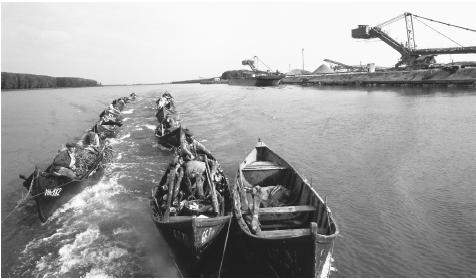
Fishermen in boats on the Danube near a fishing village. All fishermen officially work for the state, though they survive by selling 70 percent of their catch on the black market.
22 percent of the population lives below the poverty line.
After World War II, the communists built up the industrial sector and introduced a nationalized economic system. Large building projects left the country with debts; to pay them off, the government exported much of what it produced and imported little, creating shortages of consumer goods and food. Since 1989, the government has introduced reforms to create a free-market economy, privatizing some businesses and removing price controls. Although prices have gone up, wages have not; while more consumer goods are now available, many people cannot afford to buy them. Romania's currency is the leu.
Land Tenure and Property. When the communists came to power, they nationalized industries, transportation, and stores as well as private farms. The new government has begun to allow more private ownership of land, a change that has resulted in increased agricultural output. The new laws allow citizens to claim land that had been taken from their ancestors as long ago as four generations. The number of people reclaiming land is in the millions.
Commercial Activities. Many of the products produced for domestic sale are agricultural. The main crops are wheat, corn, sugar beets, sunflower seeds, and wine grapes. Farmers also raise cows, pigs, sheep, and chickens. Despite some improvement under the new government, shortages continue to be a problem, and consumers often wait in long lines to buy whatever the stores have in stock.
Major Industries. The primary industries include mining, timber, construction materials, metallurgy, chemicals, and machine building. Many industries have foundered in recent years, as they use old-fashioned equipment and are unable to compete with those of other countries. Since the early 1990s, tourism has become a growing industry.
Trade. Under communism, the Soviet Union was the primary trade partner. The Soviets sent raw materials that were processed in Romanian factories and then sold back to the Union of Soviet Socialist Republics (U.S.S.R.). Russia and the former Soviet republics remain important trading partners; others are Germany, Italy, France, and the United States. Exports include textiles and shoes, metals and metal products, and machinery and equipment. The main imports are coal, natural gas, and crude oil as well as machinery and consumer goods.
Division of Labor. In an effort to build up the industrial base, the communist government moved some of the rural population to the cities, creating a shortage of farmers. Most of those who left were younger males, and the agricultural sector came to be composed primarily of women and older men.
The communist state valued science much more highly than the humanities and other fields and pushed young people to pursue careers in those areas. In the early 1990s, a significant number of people switched jobs as more opportunities arose; it was not uncommon to see former doctors and scientists entering fields such as journalism and sales.
The poor often have little choice of profession. Education is expensive, and the children of farmers and factory workers do not have much opportunity for advancement.
Social Stratification
Classes and Castes. The majority of the people are poor, and the overall standard of living is low compared to that of Western Europe. Under communism, a small elite had access to luxuries unthinkable to most of the population. Ceaucescu, for example, lived in a forty-room palace where walls were hung with artwork taken from churches and museums. Some of the old elite have managed to hold onto their wealth and power in the government after Ceaucescu's ouster. In general, however, few rise above the generally low standard of living.
Symbols of Social Stratification. Cars are rare, and people who own them are usually part of the elite. Other imported consumer goods and household appliances are also expensive and difficult to come by and represent another symbol of high economic standing. It is also a mark of wealth to be able to send one's children to the best day-care centers and provide them with private tutoring.
In the cities, the majority of the people wear Western-style clothing. In rural areas, some people still wear traditional garb. For women, this consists of wool skirts and vests whose embroidery varies from region to region. For men, it is a white blouse and pants cinched with a wool or leather belt and a cap or hat.
Throughout the country, Roma stand out in their brightly colored clothes. Women wear long flowing skirts, and men dress in white shirts with colorful sashes.
Hairstyles are often an indication of a woman's region of origin and marital status. Unmarried women wear their hair in braids, while married women cover their heads with cloths called naframa.
Political Life
Government. The president is the head of state and is elected by popular vote for a four-year term. He appoints the prime minister, who serves as the head of government. The prime minister appoints a cabinet called the Council of Ministers. The legislature is bicameral. The Senate ( Senat ) has 143 members, and the Chamber of Deputies ( Adunarea Deputatilor ) has 343 members. All legislators are elected by direct popular vote for four-year terms.
On the local level, the country is divided into forty districts administered by mayors and councils elected by the people. The head of each region is a prefect appointed by the central government.
Leadership and Political Officials. The 1991 constitution established a multiparty system. Sixteen parties are represented in the government, and there are several smaller ones that have not won seats. These parties are composed of former communists who favor gradual change, democrats pushing for faster reform, and groups representing the interests of the different ethnic minorities. After the corrupt and often brutal policies of Ceaucescu and other leaders, the people are wary of government officials in general.
Social Problems and Control. The majority of the crimes committed are nonviolent. Economic crimes are a significant problem; corruption, speculation, hoarding, and black market activities are all prevalent. Juvenile crime is also a concern. The legal system, previously a combination of civil law and communist legal theory, is now based on the constitution of France's Fifth Republic.
Military Activity. The military consists of the Army, the Navy, the Air and Air Defense Forces, the Paramilitary Forces, and Civil Defense. In 1996, Romania spent $650 million annually on the military, or 2.5 percent of the gross domestic product. During Ceaucescu's reign, paramilitary forces often were used to suppress uprisings or dissenting activity, and the security police tapped telephones, persecuted religious authorities, and instilled fear in the populace.
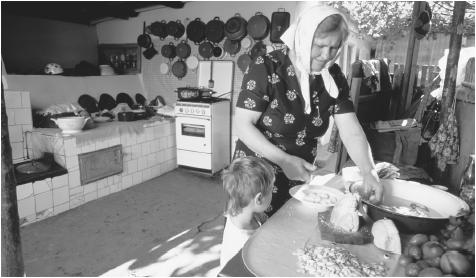
A young boy stands near his mother as she washes vegetables. The cloth covering a married woman's head is called a naframa.
Social Welfare and Change Programs
The communist government instituted a system of social welfare under which assistance was provided only to employees of the state. These workers are still entitled to pensions for retirement, disability, and survivors as well as insurance in case of sickness or injury. The state also has programs for orphans, the mentally and physically handicapped, and the elderly. Many of these programs are inadequate; in the 1980s, older people were discouraged from going to hospitals because of a lack of staff and supplies. The responsibility for caring for the elderly often falls to the family.
Nongovernmental Organizations and Other Associations
Various human rights and professional associations are active in the country. Many, such as the Children's Relief Network and Aid for Romanian Children, direct their efforts toward improving conditions in orphanages and helping thousands of abandoned children find homes. Some of these groups have a religious affiliation; others, such as the United States Agency for International Development (USAID), are funded by the governments of foreign countries.
Gender Roles and Statuses
Division of Labor by Gender. The communists attempted to get women into the work force in large numbers. While the majority of women work outside the home, they tend to occupy lower-level positions and generally are in traditional female fields, such as primary school education. Women also make up a large proportion of agricultural workers; as men left farming in the 1950s and 1960s, women were left behind in those jobs, which had come to be considered undesirable. While the definition of women's work has expanded, that of men's work has not, and women who work full-time outside the home are still expected to do all the cooking and housekeeping.
The Relative Status of Women and Men. After World War II, the communists succeeded in raising women's legal status, giving them equal rights in marriage and the workplace. Ceaucescu's regime was in many ways a step backward for women. His efforts to increase the population burdened women with either bearing children they did not want and could not afford or seeking illegal and dangerous abortions. The government also enforced mandatory gynecological examinations of women of
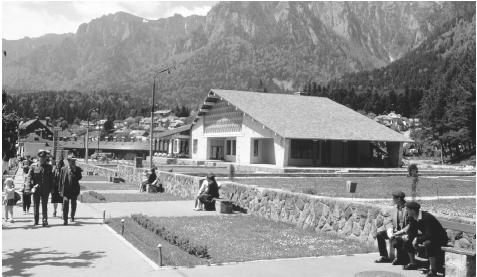
A Romanian town and the Transylvanian Alps. The highest peak in the country, Mount Moldoveanu, is located in these Alps.
childbearing age to prove that they had not had abortions.
Marriage, Family and Kinship
Marriage. Traditionally, marriages were arranged by the couple's parents through a matchmaker. The bride's family was expected to contribute a dowry that usually consisted of linen and embroidery. Traditional rural weddings were large festivities to which the entire village was invited. The ceremony included not just the couple and their parents but grandparents, godparents, the matchmaker, attendants, speakers, cooks, and numerous other people.
Today it is customary for young people to choose their own spouses, but certain elements of the traditional ceremony are preserved. The bride's hair is braided in an elaborate style, and she dons a crown of flowers, jewels, and ribbons. The groom wears a white leather vest and a hat decorated with feathers, flowers, and leaves. The best man shaves the groom's beard to symbolize his departure from his previous lifestyle. In the ceremony, both the bride and the groom ask their parents to forgive them for leaving the family.
In their effort to undermine religion, the Communists made civil ceremonies a legal requirement and discouraged church weddings. They also gave women greater rights in marriage, including equal control of children and property. When divorce laws were liberalized, the rates of divorce skyrocketed. To stem that trend, stricter laws were imposed in the 1960s, and divorce rates fell somewhat but remain high.
Domestic Unit. It is not uncommon for several generations to live together. Housing shortages force many people to live in close quarters. In the 1980s, the national average was ten square meters of living space per person; this has improved slightly, but not nearly to the goal set by the government of fourteen square meters per person by 2000.
Inheritance. Traditionally, an estate passes to the oldest son. Today, however, women are legally allowed to inherit property.
Kin Groups. The national culture places a high value on helping extended family members. An example of this was Ceaucescu's government, which was largely staffed by his relatives. Traditional families were large patriarchal units, as extra hands were always needed in the fields. Urbanization has led to smaller families, however, and to a decrease in the importance of family ties.
Socialization
Infant Care. Ceaucescu made childbearing a priority in an effort to increase the population. He outlawed abortion and birth control and declared that each woman should have at least five children. While his policies were successful in producing more children, this was in many cases to the detriment of the children. Already poor families could not afford to feed or clothe them, and the orphanages filled with abandoned babies.
Child Rearing and Education. The communist government encouraged women to work outside the home and established state-run day-care centers called crèches. From a very young age, children are left in these centers all day while their parents work. Many crèches are overcrowded and insufficiently staffed. The largest day-care center is at Scinteia in Bucharest, which is exclusively for children of the elite.
School is free and mandatory from the ages of six to sixteen. From ages six to fourteen, children attend elementary school; after this, they must pass examinations to enter secondary school. About half these students go on to vocational schools; others continue their education at technical institutes or teacher-training programs.
Higher Education. Only 5 percent of students take a college preparatory course in secondary school. To study at a university, it is necessary to pass a rigorous examination that often requires expensive tutoring outside of school. The largest and most prestigious university is the University of Bucharest, founded in 1864. Other centers of higher education include Babes-Blyai University in Cluj-Napoca and the Polytechnic Institute in Bucharest.
Etiquette
Romanians are known for hospitality and generosity. Guests are always fed. Men indicate their respect for women by a tip of the hat, a kiss on the hand, or standing to offer them a seat. It is also customary for younger people to defer to their elders.
Religion
Religious Beliefs. Seventy percent of the population is Romanian Orthodox, 6 percent is Roman Catholic (of which 3 percent is Uniate), 6 percent is Protestant, and 18 percent professes no religious affiliation. Under communism, religion was suppressed; churches were destroyed, and clergy were arrested. The government restricted religious practice but did not forbid it. The Romanian Orthodox Church as a whole did not oppose the government, and in many instances priests were used as tools of the administration.
Romanian Orthodoxy traces its history back to the Great Schism between Eastern and Western Christianity of 1054. The Eastern Orthodox Church, of which the Romanian Orthodox Church is one branch, has developed a more mystical slant than Roman Catholicism. Icons—images representing Christ, angels, saints, and other holy figures—hold an important place in Orthodox practice. They are considered a connection between the earthly and spiritual realms; it is believed that the saint is incarnated in the physical materials of the icon.
Religious Practitioners. The highest figure in Eastern Orthodox religion is the Patriarch of Constantinople. He is not considered infallible. Many Romanian priests lost the trust of their parishioners by working with the secret police during the communist regime. Some resisted, such as Laszlo Tokes, whose opposition to government intimidation led to popular acts of rebellion that ultimately led to Ceaucescu's ouster.
Rituals and Holy Places. Romanian Orthodox churches follow a specific pattern in the placement of icons. On the door there are usually life-size representations of the archangels Gabriel and Michael, above which there are several rows of other icons, including saints, martyrs, and apostles. Inside the church, there is a wall called an iconostasis where the images are displayed. On the feast day of a saint, that icon is placed on the altar for worshipers to kiss. It is customary for a family to have an icon in the home as well. When entering a house, guests cross themselves and bow to the icon before greeting the hosts.
Eucharist, or Holy Communion, is the central ritual in Orthodox services. During services on Sunday mornings, hundred of candles are lit and the smell of incense fills the church. Worshipers do not sit or kneel but stand erect.
Easter is the most important holiday in the Eastern Orthodox calendar. Its observation begins on Palm Sunday, when palm leaves or pussy willows are brought home from church. This is followed by the forty-day period of atonement of Lent, which ends on Good Friday. Easter Sunday, three days later, is celebrated with elaborately decorated eggs, feasting, and a midnight mass.
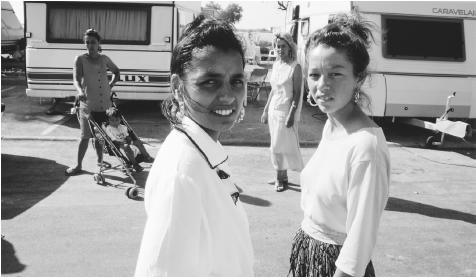
Roma women standing near their motor homes. Many Roma are not culturally assimilated into modern Romanian culture.
Christmas celebrations begin on 6 December (Saint Nicolas's Day), with family feasts. On the night before Christmas, young people wear costumes and perform colinde, traditional songs expressing hopes for good luck.
Death and the Afterlife. The belief in vampires popularized in the late 1800s by the story of Dracula has a long history in folk culture and is still followed in more traditional rural communities. It is believed that sometimes the soul does not leave the body after death, in which case the corpse does not decay but haunts the village of the deceased and can claim victims with a touch or even a glance. Garlic is thought to be helpful in keeping vampires away, as are food offerings made on Saint George's Day (23 April) and Saint Andrew's Day (29 November). The custom of covering mirrors in the home of the deceased has its origin in vampirism and the fear that the spirit of the dead person will see its reflection and not be able to leave.
Medicine and Health Care
The health care system improved under the communist government, which provided free medical services to all citizens. Development was uneven, and while conditions in the cities improved markedly, rural villages continued to suffer from a lack of doctors and facilities.
Environmental degradation has had negative effects on the health of the populations. Air pollution causes eye and lung disease, and many people do not have access to clean drinking water.
Many of the country's health problems are related to reproductive health and child care. Under Ceaucescu, abortion and birth control were banned; illegal abortions were common and often resulted in health problems. Many women were compelled to have children they could not support. Poor prenatal care and lack of food meant that many of those children were born prematurely and underweight; many were fed intravenously in hospitals with contaminated needles and contracted the AIDS virus. AIDS is a growing health concern, although the government has been slow to act and wary to release statistics. The main causes of death are cancer, cardiovascular disease, and alcoholism.
Secular Celebrations
New Year's Day is celebrated on 1 and 2 January. In Moldavia, the new year is brought in by a procession of people dressed as goats. In a rural tradition called plugusorul, a plow is decorated with green leaves and pulled throughout the village. Labor Day
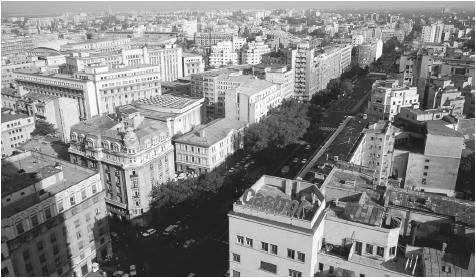
An overview of Bucharest's varied architecture. In the 1920s and 1930s, Bucharest was called "the Paris of the East."
is celebrated on 1 and 2 May, and Independence Day on 23 and 24 August, and the National Day of Romania on 1 December.
Different regions have traditions of spring and summer festivals, including the Pageant of the Juni in the city of Brasov, which is celebrated with parades, and sinzienele, which is observed throughout the country near the time of the summer solstice.
The Arts and Humanities
Support for the Arts. Under communism, the government forced artists to join unions, which supported them but censored their work. Today there is less state support for artists but more creative freedom.
Literature. The national literature traces its roots back to early ballads and folklore. The ballad form, which was most popular between the sixteenth and nineteenth centuries, often involved pastoral tales sung to the accompaniment of a lute or zither. The best-known folktale is that of Dracula, which was made famous by foreign authors. Ion Creanga, a nineteenth-century writer, was famous for his use of traditional storytelling techniques in fiction and memoirs. More contemporary writers are known for mixing politics, history, and literature. In the late nineteenth century, the Moldavian poet Mihai Eminescu celebrated the country's history and culture. In that period, Ion Luca Caragiale wrote comic plays that dealt with political issues.
Romanian writers have made considerable contributions abroad. Tristan Tzara, who left for France during World War I, was one of the founders of the Dadaist movement. Eugene Ionesco (1912–1994), another expatriate who lived in France and wrote in French, composed the famous absurdist dramas The Rhinoceros and The Bald Soprano.
Graphic Arts. Traditional art forms include woven wool rugs, pottery, and wood carving. More folk art is preserved in the northwest region of Maramures than anywhere else in the country. Doorways, gates, and windows are carved with elaborate designs. Traditional costumes are also works of art, often displaying elaborate embroidery and a trimming of tiny glass beads.
Several painters rose to prominence in the nineteenth century after studying in Western Europe, including Nicolae Grigorescu, known for landscapes and depictions of rural life, and the portraitist Theodor Aman. Social realism dominated in the post-World War II period as the communist government compelled artists to produce works that glorified industrial workers and political leaders.
The most famous modern artist was Constantin Brancusi (1876–1957), a sculptor who made his home in France. He worked in wood and metal, creating abstract representations of people and nature. Late in his career, he was invited to create several sculptures for display in Tirgu-Jiu, the village of his birth. His works The Kissing Gate and Table of Silence are in a public park there.
Performance Arts. Romanian folk music is often mournful, such as the doina of the northwest. Common instruments include nai (panpipes), tembal (dulcimer), bacium (a long wooden wind instrument), gorduna (small double bass), and violins. Many folk musicians are Roma.
The national dance is the hora, a circle dance performed at festive occasions. Different regions have unique dances performed in pairs and groups.
Several Romanians have achieved prominence in classical music, including the pianist and conductor Dinu Lipatt and Georges Enesco, a violinist and composer whose work was influenced by traditional folk songs.
Drama companies in Bucharest and other cities' stage productions of classical Romanian works as well as contemporary pieces by national and foreign playwrights.
Early in the twentieth century, Bucharest became one of the centers of Eastern European filmmaking. In 1957, Ion Popescu-Gopo won an award at the Cannes Film Festival for an animated allegorical film called Brief History. Romanian filmmakers dealt with the repressive political environment of the 1970s in "iceberg movies" in which they disguised social and political statements in ostensibly innocent stories.
The State of the Physical and Social Sciences
The communist government gave science and technology priority over the humanities and social sciences. Subjects such as history and literature were tightly censored and viewed as vehicles for ideological indoctrination. Since communism fell, these fields have benefitted from more freedom of expression. The Department of Comparative Literature at the University of Bucharest reopened in the early 1990s after having been defunct for twelve years.
The center of academic research is the Romanian Academy. It has a library of over seven million volumes and a publishing house called Editura Academiei that prints academic papers and journals.
Bibliography
Balas, Egon. Will to Freedom: A Perilous Journey through Fascism and Communism, 2000.
Bran, Mirel. "Romania: Computer-Generated Freedom." UNESCO Sources, February 2000.
Davies, Alan I. "The Secret of Fast Food in Romania." Contemporary Review, October 1, 1998.
"An Ex-President, the 'Less Bad' of Two Candidates, Wins Romania." Philadelphia Inquirer, December 11, 2000.
Lewy, Guenter. "The Travail of the Gypsies." National Interest, Fall 1999.
Michelson, Paul E. Romanian Politics 1859–1871: From Prince Cuza to Prince Carol, 1998.
Pop, Ioan Aurel. Romanians and Romania: A Brief History, 1999.
Rodina, Mihaela. "Bucharest Blues." UNESCO Sources, March 1997.
Roper, Steven D. Romania: The Unfinished Revolution, 2000.
Shen, Raphael. Restructuring of Romania's Economy: A Paradigm of Flexibility and Adaptability, 1997.
Siani-Davis, Peter, and Mary Siani-Davis, compilers. Romania, 1998.
"The Tortoise and the Hare." The Economist, August 7, 1999.
Treptow, Kurt W., ed. History of Romania, 1997.
U.S. Department of State, Bureau of Democracy, Human Rights, and Labor. Human Rights Report on Romania, February 28, 1999.
